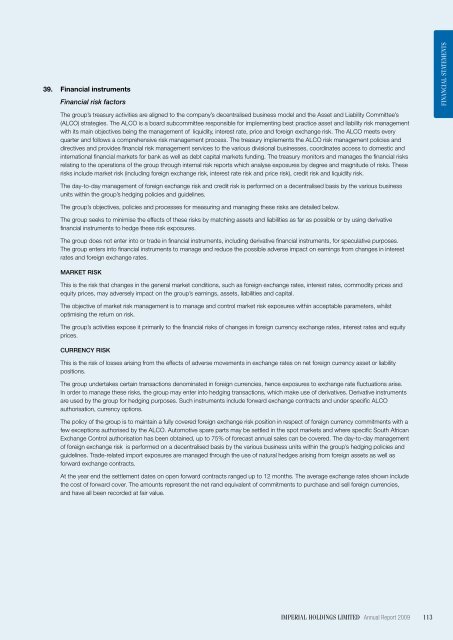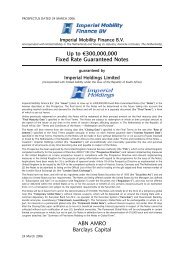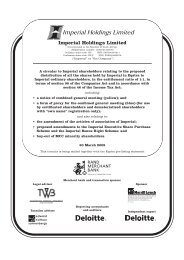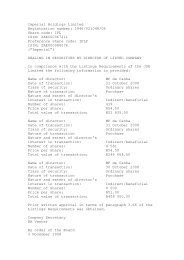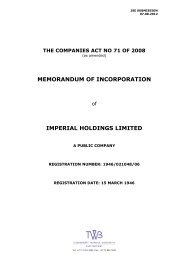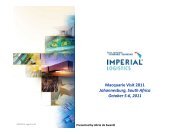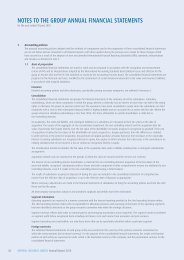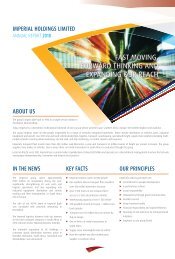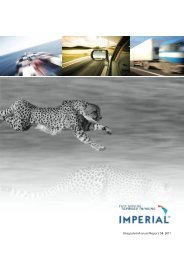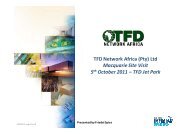4.0 - Imperial
4.0 - Imperial
4.0 - Imperial
Create successful ePaper yourself
Turn your PDF publications into a flip-book with our unique Google optimized e-Paper software.
39. Financial instruments<br />
Financial risk factors<br />
Financial Statements<br />
The group’s treasury activities are aligned to the company’s decentralised business model and the Asset and Liability Committee’s<br />
(ALCO) strategies. The ALCO is a board subcommittee responsible for implementing best practice asset and liability risk management<br />
with its main objectives being the management of liquidity, interest rate, price and foreign exchange risk. The ALCO meets every<br />
quarter and follows a comprehensive risk management process. The treasury implements the ALCO risk management policies and<br />
directives and provides financial risk management services to the various divisional businesses, coordinates access to domestic and<br />
international financial markets for bank as well as debt capital markets funding. The treasury monitors and manages the financial risks<br />
relating to the operations of the group through internal risk reports which analyse exposures by degree and magnitude of risks. These<br />
risks include market risk (including foreign exchange risk, interest rate risk and price risk), credit risk and liquidity risk.<br />
The day-to-day management of foreign exchange risk and credit risk is performed on a decentralised basis by the various business<br />
units within the group’s hedging policies and guidelines.<br />
The group’s objectives, policies and processes for measuring and managing these risks are detailed below.<br />
The group seeks to minimise the effects of these risks by matching assets and liabilities as far as possible or by using derivative<br />
financial instruments to hedge these risk exposures.<br />
The group does not enter into or trade in financial instruments, including derivative financial instruments, for speculative purposes.<br />
The group enters into financial instruments to manage and reduce the possible adverse impact on earnings from changes in interest<br />
rates and foreign exchange rates.<br />
Market risk<br />
This is the risk that changes in the general market conditions, such as foreign exchange rates, interest rates, commodity prices and<br />
equity prices, may adversely impact on the group’s earnings, assets, liabilities and capital.<br />
The objective of market risk management is to manage and control market risk exposures within acceptable parameters, whilst<br />
optimising the return on risk.<br />
The group’s activities expose it primarily to the financial risks of changes in foreign currency exchange rates, interest rates and equity<br />
prices.<br />
Currency risk<br />
This is the risk of losses arising from the effects of adverse movements in exchange rates on net foreign currency asset or liability<br />
positions.<br />
The group undertakes certain transactions denominated in foreign currencies, hence exposures to exchange rate fluctuations arise.<br />
In order to manage these risks, the group may enter into hedging transactions, which make use of derivatives. Derivative instruments<br />
are used by the group for hedging purposes. Such instruments include forward exchange contracts and under specific ALCO<br />
authorisation, currency options.<br />
The policy of the group is to maintain a fully covered foreign exchange risk position in respect of foreign currency commitments with a<br />
few exceptions authorised by the ALCO. Automotive spare parts may be settled in the spot markets and where specific South African<br />
Exchange Control authorisation has been obtained, up to 75% of forecast annual sales can be covered. The day-to-day management<br />
of foreign exchange risk is performed on a decentralised basis by the various business units within the group’s hedging policies and<br />
guidelines. Trade-related import exposures are managed through the use of natural hedges arising from foreign assets as well as<br />
forward exchange contracts.<br />
At the year end the settlement dates on open forward contracts ranged up to 12 months. The average exchange rates shown include<br />
the cost of forward cover. The amounts represent the net rand equivalent of commitments to purchase and sell foreign currencies,<br />
and have all been recorded at fair value.<br />
<strong>Imperial</strong> holdings limited Annual Report 2009 113


